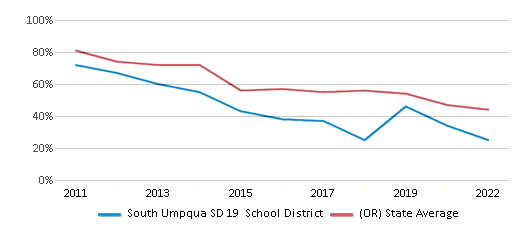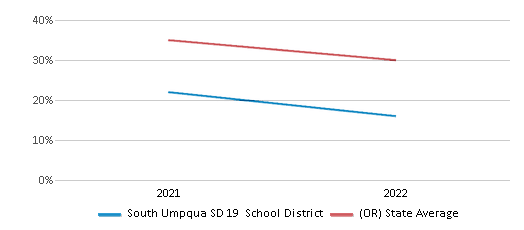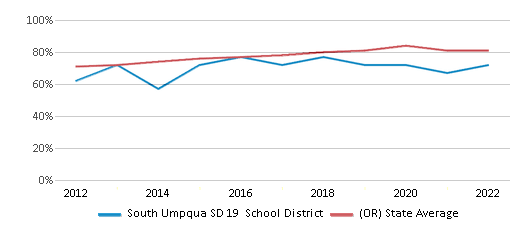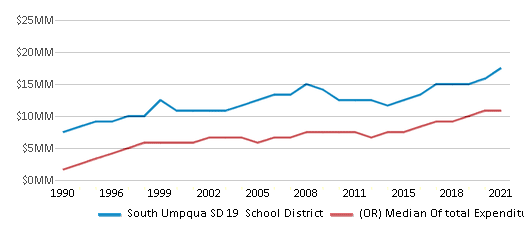For the 2025 school year, there are 2 public preschools serving 544 students in South Umpqua SD 19 School District. This district's average pre testing ranking is 1/10, which is in the bottom 50% of public pre schools in Oregon.
Public Preschools in South Umpqua SD 19 School District have an average math proficiency score of 12% (versus the Oregon public pre school average of 33%), and reading proficiency score of 22% (versus the 42% statewide average).
Minority enrollment is 22% of the student body (majority Hispanic), which is less than the Oregon public preschool average of 52% (majority Hispanic).
Overview
This School District
This State (OR)
# Schools
6 Schools
91 Schools
# Students
1,448 Students
29,714 Students
# Teachers
51 Teachers
1,885 Teachers
Student : Teacher Ratio
28:1
28:1
District Rank
South Umpqua SD 19 School District, which is ranked within the bottom 50% of all 186 school districts in Oregon (based off of combined math and reading proficiency testing data) for the 2021-2022 school year.
The school district's graduation rate of 70-74% has stayed relatively flat over five school years.
Overall District Rank
#177 out of 189 school districts
(Bottom 50%)
(Bottom 50%)

Math Test Scores (% Proficient)
14%
31%

Reading/Language Arts Test Scores (% Proficient)
25%
44%

Science Test Scores (% Proficient)
16%
30%

Graduation Rate
70-74%
81%

Students by Ethnicity:
Diversity Score
0.38
0.67
# American Indian Students
26 Students
200 Students
% American Indian Students
2%
1%
# Asian Students
10 Students
1,549 Students
% Asian Students
1%
5%
# Hispanic Students
153 Students
8,817 Students
% Hispanic Students
11%
30%
# Black Students
8 Students
1,664 Students
% Black Students
n/a
6%
# White Students
1,129 Students
14,394 Students
% White Students
78%
48%
# Hawaiian Students
4 Students
371 Students
% Hawaiian Students
n/a
1%
# Two or more races Students
113 Students
2,665 Students
% of Two or more races Students
8%
9%
Students by Grade:
# Students in PK Grade:
-
-
# Students in K Grade:
86
4,906
# Students in 1st Grade:
110
4,696
# Students in 2nd Grade:
105
4,983
# Students in 3rd Grade:
116
4,490
# Students in 4th Grade:
107
4,747
# Students in 5th Grade:
132
4,341
# Students in 6th Grade:
123
599
# Students in 7th Grade:
102
330
# Students in 8th Grade:
113
296
# Students in 9th Grade:
116
77
# Students in 10th Grade:
124
82
# Students in 11th Grade:
109
91
# Students in 12th Grade:
105
76
# Ungraded Students:
-
-
District Revenue and Spending
The revenue/student of $15,481 in this school district is less than the state median of $18,279. The school district revenue/student has stayed relatively flat over four school years.
The school district's spending/student of $14,275 is less than the state median of $19,325. The school district spending/student has stayed relatively flat over four school years.
Total Revenue
$22 MM
$9,902 MM

Spending
$21 MM
$10,468 MM

Revenue / Student
$15,481
$18,279

Spending / Student
$14,275
$19,325

Best South Umpqua SD 19 School District Public Preschools (2025)
School
(Math and Reading Proficiency)
(Math and Reading Proficiency)
Location
Grades
Students
Rank: #11.
Tri City Elementary School
(Math: 15-19% | Reading: 25-29%)
Rank:
Rank:
2/
Bottom 50%10
546 Sw Chadwick Ln
Myrtle Creek, OR 97457
(541) 863-6887
Myrtle Creek, OR 97457
(541) 863-6887
Grades: PK-5
| 272 students
Rank: #22.
Myrtle Creek Elementary School
(Math: 6-9% | Reading: 15-19%)
Rank:
Rank:
1/
Bottom 50%10
651 Ne Division
Myrtle Creek, OR 97457
(541) 863-3168
Myrtle Creek, OR 97457
(541) 863-3168
Grades: PK-5
| 272 students
Recent Articles

Year-Round Or Traditional Schedule?
Which is more appropriate for your child? A year-round attendance schedule or traditional schedule? We look at the pros and cons.

Why You Should Encourage Your Child to Join a Sports Team
Participating in team sports has a great many benefits for children, there is no doubt. In this article you will learn what those benefits are.

White Students are Now the Minority in U.S. Public Schools
Increasing birth rates among immigrant families from Asia and Central and South America, combined with lower birth rates among white families, means that for the first time in history, public school students in the United States are majority-minority. This shift in demographics poses difficulties for schools as they work to accommodate children of varying language abilities and socio-economic backgrounds.





